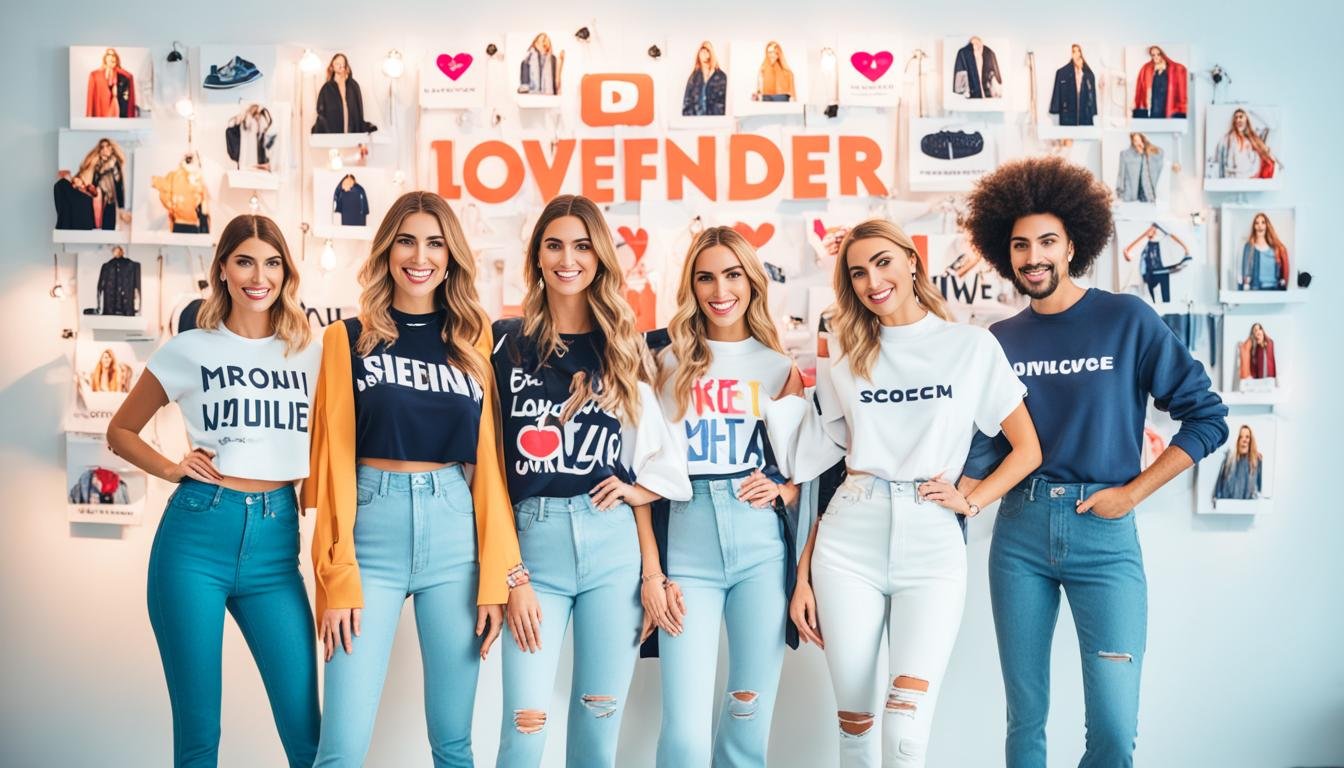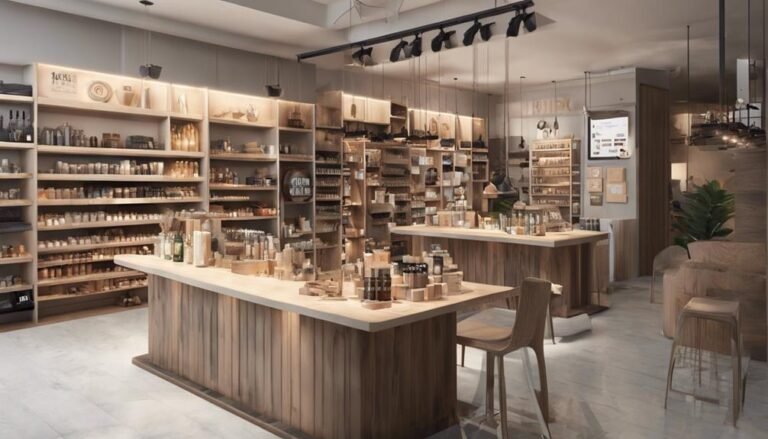Influencer Marketing for Fashion Brands
The old days of fashion marketing were about getting into Vogue or a Times Square billboard. But then, the digital age came along, changing everything fast. I’ll never forget when I first saw familiar faces endorsing brands on Instagram a few years ago. Companies like Abercrombie & Fitch were now being promoted by influencers. This marked the start of a major shift in marketing strategies.
Today, influencer marketing is key for building fashion brands. It helps them connect with their audience like never before. There are over 4.2 billion social media users worldwide. This means brands have an affordable and active platform to find new customers. Being mobile-friendly is crucial since almost everyone (98.8%) uses social media on their phones. It ensures easy, genuine, and quick interactions.
Abercrombie & Fitch saw their stock value grow more than 285% in a year. Through smart influencer partnerships, they broke sales records in the first quarter. Princess Polly is another success story. By sharing discount codes with influencers, they boosted their U.S. sales by 60%. Revolve’s strategy is also impressive. Their REMI x REVOLVE collection showed they know how to excel in their sector.
In 2019, the global market for fashion influencer marketing was worth $1.5 billion. Shockingly, its value is expected to skyrocket. By 2027, analysts predict a yearly growth rate of 35.7%. By 2023, it had already reached $21.1 billion. And by 2024, it may go beyond $24 billion. Even brands like Chanel, known for traditional marketing, are now exploring influencer marketing. This change speaks volumes about the industry’s direction.
Key Takeaways
- Influencer marketing has transformed how fashion companies connect with consumers.
- There are over 4.2 billion social media users worldwide, offering vast customer potential.
- Success stories from Abercrombie & Fitch and Princess Polly highlight the power of influencer marketing on sales and stock.
- The fashion influencer marketing sector is rapidly growing, with projections to surpass $24 billion by 2024.
- Even established brands like Chanel are adopting influencer marketing, showing a big shift in the industry.
The Evolution of Fashion Marketing in the Social Media Era
Social media influencers have greatly changed how fashion is marketed. It’s now an era of digital marketing transformation. In the past, fashion ads were mostly in magazines and on TV. But with Instagram and TikTok, marketing is now interactive and driven by influencers.
Instagram is now the top platform for working with influencers. 72% of marketers prefer it for influencer collaborations. And a big reason for this is that most people, 69%, trust influencers more than traditional ads. This trust means working with influencers is great for connecting with people and boosting sales.
eCommerce growth and social media have changed fashion marketing a lot. The fashion influencer marketing industry is growing fast, expected to be worth nearly $15 billion by 2027. That’s how important influencers have become for fashion business success. A survey in 2019 showed that 86% people bought clothes because influencers they follow recommended them.
There’s success with influencers of all sizes. Brands can see this through different influencer categories, like nano-influencers or micro-influencers. This variety lets brands focus on their specific audience and engage with them better.
Zara, Shein, and Nike are top fashion brands today. They use influencer marketing well to connect with people and stay visible. Instagram is key for them, sparking direct interaction and promoting fashion trends worldwide.
TikTok is known for setting new fashion trends with its short videos. Its fast-engagement-based system helps these trends go viral. Pinterest, on the other hand, acts as a large source of fashion ideas, helpful for predicting future trends.
The fashion world is increasingly shaped by social media. Influencers are central to how brands advertise. Digital tactics like influencer marketing and data analysis are crucial. Even though these methods quickly spread fashion ideas, they also pose questions about their long-term impact and ethics.
Overall, social media has made fashion more accessible. It started with traditional ads but has now evolved greatly. From blogs to today’s influencers, fashion marketing continues to keep up with new tech and customer needs.
Why Fashion Brands Should Use Influencer Marketing
Fashion brands are embracing influencer marketing to break through in the competitive market. They want to form real connections with their audiences. By using influencers, brands get quick access to specific market groups. This method helps not only involve the right customers but also builds trust in the brand.
Instagram, TikTok, and Pinterest play a crucial role in fashion influencer marketing. They let customers and influencers have direct talks. This creates genuine reviews and endorsements from people they trust. For example, Gucci used a TikTok filter to make its eyewear line popular, teaming up with influencers to widen their reach.
Brands like Abercrombie & Fitch, Princess Polly, and Revolve have seen remarkable results from influencer collaborations. These strategies led to real growth and a strong presence online. They show how influencer marketing can have a major impact on sales.
Choosing micro-influencers over macro-influencers can lead to better engagement. With fewer followers, micro-influencers provide a sense of closeness. They make promoting products in everyday life settings more authentic. Adidas, for instance, has worked with micro-influencers to target various groups, from travel lovers to TikTok stars.
High-end labels and mainstream fashion sellers use different influencer marketing tactics but see its worth in promoting their brands. They make sure to set clear goals with influencers, describing what they want and how they’ll measure success. Companies like Skeepers help these brands find the right influencers. This speeds up their campaign responses and boosts results.
In India, the impact of influencers is rapidly increasing. The industry is expected to grow by 25% each year until 2025. This shows how influencers change what people buy and how much they trust brands.
- Influencer marketing generates authentic endorsements.
- Micro-influencers often yield higher engagement within their community.
- Brands like BOSS leverage TikTok influencers to expand their reach.
In the end, influencer marketing can reinvigorate a brand’s image and introduce it to new people. The key is to carefully plan campaigns that use both micro- and macro-influencers.
| Brand | Platform | Outcome |
|---|---|---|
| Gucci | TikTok | Broad audience engagement |
| Adidas | Various (including TikTok) | Diverse demographic reach |
| Gémo | Multi-platform | 80,000 interactions, €24,000 media value |
By working with influencers, fashion brands can see significant sales growth while gaining the trust and love of their audience.
Types of Influencers: From Celebrities to Micro-Influencers
Influencer marketing is changing how the fashion world works. It gives brands chances to reach out in various ways. For fashion brands, knowing about influencers is key. It helps them use endorsements, huge followings, and famous partnerships to their advantage. Now, let’s look at the main influencer categories and what they offer.
Celebrity Influencers
Celebrity influencers are very famous people. They are known by many. Because of this, when they support something, people pay attention. Powerful and well-known, they often have followers in the millions. Celebrities like Kylie Jenner and Cristiano Ronaldo fall into this category. They charge a lot for their endorsements, which can be around $2.3 billion per post.
Working with these celebrities can be really expensive. But the brand recognition they bring is huge. Brands can make $5.78 for every dollar they invest in working with influencers like this. This shows the big return brands can get.
Macro-Influencers
Macro-influencers have between 100,000 to one million followers. They hold special expertise and have a lot of interaction with their followers. This is great for fashion brands that want to reach certain groups and a lot of people at the same time. These are like internet stars who appeal to many, making them both relatable and influential.
Using macro-influencers is good for growing brand awareness without spending as much as with celebrity influencers. Working with them allows brands to make top-tier partnerships. They can work with influencers who have a lot of followers and impact.
Micro-Influencers
Micro-influencers have between 10,000 to 100,000 followers. They have a strong connection with their followers. They are usually seen as specialists in a certain area. Because of this, they often lead to high levels of people actually buying something from their recommendations. For fashion brands, these influencers are a smart way to reach small but interested groups.
Being relatable and real, micro-influencers get a lot of interaction. They are a good choice for brands aiming at specific groups. The strong connections they have with their audience let fashion brands really connect with people and see a great return on investment.
In conclusion, knowing about different influencer types is really useful for fashion brands. By choosing the best fit, brands can grow their reach, effects, and make more money from their marketing efforts.
Successful Influencer Marketing Campaigns by Leading Fashion Brands
Top fashion brands lead with powerful influencer marketing. They use examples to build strong fashion brand partnerships. This strategy boosts trends and connects with consumers.
Abercrombie & Fitch’s approach was inclusive and used both big names and regular people. This helped their stock grow by 285% in a year. Princess Polly, on the other hand, focused on ‘try-on hauls’ by smaller influencers. This led to quick success in the US. Revolve worked with famous influencers on collections. This made customers more loyal and raised their position in the industry.
- H&M’s push for their Fall Studio Collection through influencers
- Sperry’s Instagram campaign with 100+ small influencers
- Nike’s “Dream Crazier” Campaign featured top female athletes like Serena Williams
- Fashion Nova’s #NovaBabe Campaign used a mix of big and small influencers
- Gucci’s #GucciGift Campaign included the top influencers during the holidays
- Revolve’s #RevolveAroundTheWorld Campaign sent influencers to exotic destinations
- Adidas’ #HereToCreate Campaign celebrated uniqueness and creativity
| Brand | VIT | Mentions | Engagements |
|---|---|---|---|
| Amazon | 4.75M | 346k | 559M |
| Fashion Nova | 1.39M | 75.1k | 440M |
| Nike | 1.08M | 90.5k | 259M |
| Skims | 966k | 29.4k | 265M |
| Revolve | 733k | 53.9k | 223M |
| Walmart | 690k | 38.1k | 74.8M |
| Target | 640k | 59.6k | 94.6M |
| SHEIN | 626k | 82.8k | 153M |
| Zara | 620k | 81.3k | 165M |
| Dior | 583k | 38.2k | 218M |
Research shows 61% of US shoppers are more likely to buy from a brand they learn about from influencers. And 46% say they’d buy clothes after seeing them on social media. So, teaming up with social media stars is key for fashion brands. These partnerships not only boost brand awareness but also help build deep connections with consumers. By looking at these successful influencer campaigns, brands can learn how to do their own successful influencer marketing.
Crafting an Effective Influencer Marketing Strategy
To make your influencer marketing strategy work, you must know your brand’s goals first. Then, find the right influencers to match. By 2025, influencer marketing might hit $22.2 billion. This shows many brands see its value in meeting their goals. A strong influencer program can make people more aware of your brand, improve its image, and increase sales. In fact, more than 80% of people have trusted influencer recommendations in the past year alone.
For fashion brands to really win, they should pick influencers carefully. They need to check if the influencer and their content fit their brand’s message. How the influencer’s audience responds matters a lot too. This step is critical since over 60% of people trust what influencers say just like they trust their friends or family. Using smart tactics like special codes, fun product promotions, or sharing the profit with influencers can help. Such strategies influence about 80% of decisions to buy those products. They also win over customer loyalty.
Knowing if your influencer campaign is a success means looking at different signs. These could be likes, how many people saw the post, comments, or if the brand was mentioned. Working with influencers who are real with their followers makes a difference. Authenticity helps keep the trust. As more businesses look to spend on influencer marketing, setting money aside for these partnerships is wise. It ensures your money is well spent, bringing bigger profits over time.
FAQ
How has influencer marketing changed traditional fashion marketing strategies?
Why are influencers important for fashion brands?
What are the benefits of using social media for fashion marketing?
How do celebrity influencers help fashion brands?
What advantages do macro-influencers offer to fashion brands?
Why should fashion brands partner with micro-influencers?
Can you provide an example of a successful influencer marketing campaign by a fashion brand?
How should fashion brands craft an effective influencer marketing strategy?
What role do brand ambassadors play in influencer marketing?
How can fashion brands ensure their influencer campaigns are effective?
Source Links
- A Guide to Influencer Marketing in the Fashion Industry
- 3 Fashion Brands Styling Up Their Influencer Marketing Strategies | Aspire
- Fashion influencer marketing: all you need to know to make it work
- The Impact of Social Media Influencers on Apparel Brand Growth
- The Ultimate Guide to Social Media in Fashion: Everything You Need to Know – Uphance
- A Brief History of Fashion Marketing – Yellowbrick
- How Brands Can Nail Fashion Influencer Marketing in 2024
- How Can Fashion Brands Use Influencer Marketing? – Skeepers
- Influencer Marketing is the Fashion Industry’s new Fortune Cookie
- 12 Types of Influencers You Can Use to Improve Your Marketing
- Types of Social Media Influencers: Mega, Macro, Nano and Micro Influencers
- Top 10 Types of Influencers for Your Brand | Moburst
- 12 Successful Influencer Marketing Campaigns To Get Inspired By Top Brands – BuzzFame
- Success Stories of Five Striking Influencer Marketing Campaigns
- Top 10 Fashion Brands in Influencer Marketing of 2023 I Traackr
- How to Develop an Effective Influencer Marketing Strategy
- What is influencer marketing: An influencer strategy guide for 2024
- How to Build a Successful Influencer Strategy





